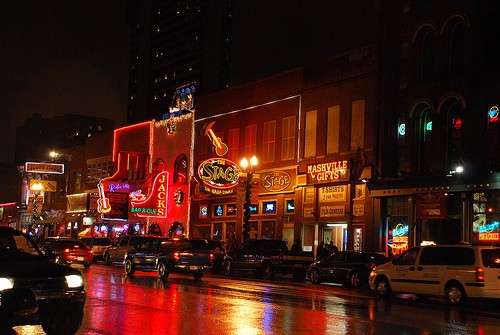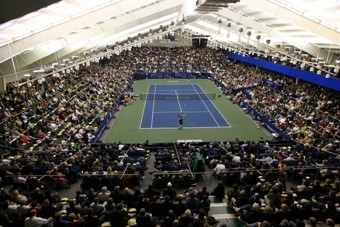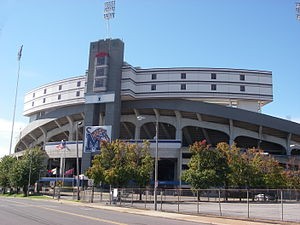The professional men’s and women’s tennis tournaments could be leaving the Racquet Club of Memphis next year for Rio de Janeiro. Big deal or, as one of our commenters succinctly put it, a big yawn?
In the big picture, this is all about “right-sizing” sports facilities and events, from the Racquet Club to AutoZone Park to Liberty Bowl Stadium to public playing fields, golf courses, and amateur sports complexes like First Tennessee Fields and Snowden Grove in DeSoto County. More on that in a minute.
First though, as someone who has played and watched tennis, racquetball, and squash at the Racquet Club for many years, I guess I should be in the “big deal” camp, but I’m not, at least not without qualifications. Teams and tournaments come and go, and this one is 36 years old and has gone by more names than an inmate in the county jail — U.S. Indoor, Volvo, Kroger, Regions Morgan Keegan to name a few. The women’s tournament, ten years old, was sponsorless this year.
If they are replaced, as seems likely, by a “lower-level” pro tournament, the average fan, not to mention the non-fan, won’t notice the difference. Case in point: Andy Roddick and Milos Raonic have been recent finalists in Memphis (a “500” tournament) and, a week earlier, San Jose (a “250” tournament). Above the satellite-tournament level, the strength of the field is determined by convenience as much as anything, and several big names have either failed to show up in Memphis or made an early exit.
The Racquet Club and the tournament are the legacy of William Dunavant Jr., founder of the club, cotton magnate, tennis player, but no longer actively involved in day-to-day Memphis. He sold the club to Mac Winker, who pledged to keep the tournament in Memphis, as indeed he did. Winker sold the club to Sharks Sports & Entertainment in San Jose, which reportedly plans to sell it to IMG, a sports marketing and management company with global connections.
Winker told me that in his early years as manager of the club, the tournament was supported by the club, but that flipped in the later years, and the tournament supported the club and its declining membership. He said his mantra was to make the tournament an event, with a St. Jude tie-in and as much fanfare and as many sponsors (bannered around the stadium court) as could be mustered. Tennis big-wigs such as Barry McKay and Donald Dell were regulars in the boxes, courtside seats were cherished, there was fancy food in the Walnut Room, and sport jackets and dresses were not uncommon for the packed finals. There was no competition from NBA basketball, and American players like Jimmy Connors, Andre Agassi, Jim Courier, Michael Chang, Brad Gilbert, Todd Martin, and Pete Sampras were among the Memphis champions and in the world Top Five.
There are more foreign players in the tournament these days, although Americans Roddick and Sam Querrey have also been recent winners along with Jurgen Melzer and Tommy Haas. But none of them are as well known as the tennis Big Four of Nadal, Federer, Djokovic, and Murray who dominate the Grand Slams.
The women’s tournament lost Cellular South as its title sponsor, and the prize money is less than the men get. The crowds for the women’s finals have been smaller, with the exception of Venus Williams matches. Overall, I think the twin tournaments suffer from “too much tennis” syndrome when you take into account split day and evening sessions, qualifying matches, singles and doubles, action on multiple courts, and $40-$60 tickets.
There is some fear among members that the Racquet Club itself could now be sold along with the tournaments. Giving credence to that, San Jose is clearly calling the shots. Tournament director Peter Lebedevs and Morgan Keegan managing partner Reggie Barnes both told me they got the news on Monday morning, like everyone else in Memphis. Lebedevs had just returned from a trip to Australia and said he couldn’t comment on a possible sale of the tournament. Allen Morgan Jr., one of the founding partners of Morgan Keegan, committed to the title sponsorship for six years and an additional year to fill the breach after the sale to Raymond James. He noted that he once tried unsuccessfully to buy the pro tournament in Atlanta. After a nine-year absence, the ATP tour returned to Atlanta in 2010, but the event is played in a smaller venue with less prize money than Memphis.
Winker, now retired, said he has been contacted by at least one company interested in putting several million dollars into another southern ATP tournament but declined to identify the company or location.
Racquet Club member and commercial real estate investor and developer Trip Trezevant thinks the future of the club is secure.
“If they (the owners) have $8 million in the club including renovations then that is now, just land cost, of $36 a foot which is too expensive for residential. The owners purchased the club to be a tennis club and I am certain that is what they will do. They have done a great job thus far on improving the club. I think we will end up getting a 250 series tennis tournament and still have the same players that we had for the 500 series and they probably got money selling the 500 series which will go back into the club to improve the club. Just a guess.”
While Winker was owner, some courts along White Station were replaced with housing, leaving the club with 11 indoor courts and 16 outdoor courts used by members and the University of Memphis.
To my eye at least, that may still be too many. I’ve seen too many empty outdoor courts on a beautiful weekend afternoon or empty indoor courts at times when they are being lighted and air-conditioned. The three racquetball courts are lightly used, and racquetball, once a Memphis institution, looks like a dying sport. As for squash, all I will say is that I helped bring the former number-one player in the world to Memphis a month ago and drew about five spectators to a free exhibition. These are not called minor sports for nothing.
It wasn’t my first sports miscalculation. Some years ago I got it in my head that outdoor basketball tournaments were a perfect fit for Memphis, but they died after a year or two downtown. Then I went through a baseball phase when my son was growing up and playing at Snowden Grove, USA Stadium in Millington, and Dulin’s academy. First Tennessee Fields filled that need, and there’s plenty of competition from baseball complexes in Jackson, Tennessee, and Jonesboro, Arkansas and Tipton County, Tennessee. AutoZone Park is too big for the Redbirds much less college or high school teams. I had a brief fling with soccer as an American fan favorite, but last week a game between the United States and El Salvador in Nashville, with an Olympics berth at stake, drew about 8,000 fans. And, briefly, I had hopes for the River Kings hockey team and indoor soccer in the Coliseum. I thought the people who go to meetings about bike lanes on North Parkway and other city streets might actually use them. And surely golfers would flock to T. O. Fuller, Riverside, and Davy Crockett when they were threatened. Nope.
I have counted the house at old Tim McCarver, new AutoZone Park, and the 60,000-seat Liberty Bowl on nights when you couldn’t get to 3,000 without kidding yourself. The only regular near-capacity crowds seem to be at FedEx Forum for the Grizzlies or Tigers. And the amateur sport that never ceases to amaze me with its growth in participation is distance running or walking for some cause.
What’s the deal? Big screen televisions. Too many venues. Ticket prices. Fees. Changing habits. Declining neighborhoods. Fitness machines. Sloth. Boredom. Whatever, tennis isn’t the only sport being right sized.


